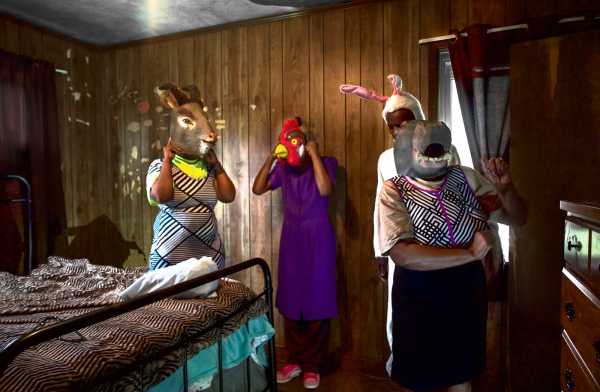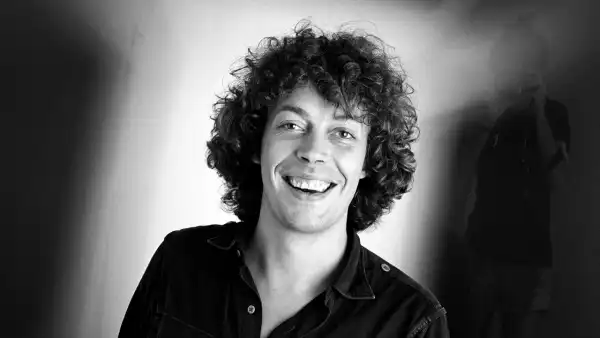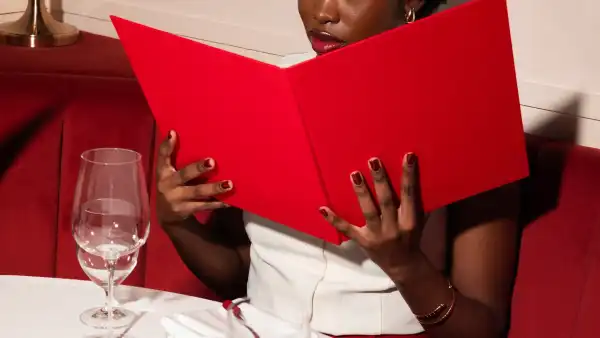
Save this storySave this storySave this storySave this story
Hilton Als
Staff writer
You’re reading the Goings On newsletter, a guide to what we’re watching, listening to, and doing this week. Sign up to receive it in your in-box.
It’s hard to believe that it’s been almost twenty years since I first saw the great director David Cromer’s work. You don’t notice time passing when you’re in the presence of a bona-fide theatrical genius: you long for what’s next while pondering what you’ve just seen. “Orson’s Shadow” was the first piece that I saw Cromer shape. That was in 2005. Up until then, I had only seen more or less conventional narratives conventionally directed; Richard Foreman and Elizabeth LeCompte of the Wooster Group were the only auteurs around, but they didn’t stage standard narrative plays. But here, on that afternoon in 2005, was an artist who had taken a character-driven piece and made it an atmosphere. The actors were lit dimly; it was like watching figures edge their way through fog to get at your dreams. After that, I kept my eyes peeled for what the director, who is now sixty, put on.
His early masterpiece was his 2009 interpretation of “Our Town,” in which he appeared as the Stage Manager. Whoever saw that production wasn’t likely to forget it. He took Thornton Wilder’s homespun tale about loss and created an elegy that made you mourn for all the living you’d eventually lose, including yourself. A year later, there was “When the Rain Stops Falling,” and there it was again, Cromer’s auteurlike influence on a spectacle that was only enhanced by his love of the lost. His dark lighting and his tendency to make a stage smaller promoted a degree of intimacy that made a version of “Rent” he did in 2012 the only version that felt true to the poverty and the poetry of those characters’ lives.
With “The Counter” (at the Laura Pels, through Nov. 17), Cromer’s gift for intimacy is in full flower. It’s fascinating to see how he makes the already small stage feel even smaller, by building it out toward the audience, so we’re sitting with the characters in that diner while they choose life over what’s been lost—and over the possibility of death. Now Cromer is slated to direct George Clooney in the stage adaptation of the 2005 movie “Good Night, and Good Luck” (beginning previews at the Winter Garden on March 12). Who better to show us the devastating effects of McCarthyism in a grim world than this true auteur of the stage, whose work is like an extra text on top of the script: gentle but probing, magical and real.

Zoë Winters, in “Walden.”
Photograph by Joan Marcus
Another standout of the theatre right now is the actress Zoë Winters, who appears in Second Stage’s production of “Walden” (at the Tony Kiser, through Nov. 24). Winters grew up in Santa Cruz, and graduated from SUNY Purchase in 2007. She is one of the great acting alumni from that school—Edie Falco is another—who are so astonishing in their natural gifts and command of the stage that you can’t help but give yourself over to their reality, even when they are unreal, demanding, entirely too strange. Despite Winters’s distinctive look—that long black hair and fringe, the generous mouth—when I covered theatre for this magazine, I often wrote about her as if I’d never seen her before. That’s because I hadn’t—not in this or that character, certainly. She was always different, and so fully immersed in each character’s inner life, that she would perforce look different. And it made a certain amount of sense for her to be in shows like Branden Jacobs-Jenkins’s “An Octoroon” (2014), or Lucas Hnath’s “Red Speedo” (2016).
Because her acting was closely linked with these then emerging playwrights’ work, she was an emerging voice in acting, too: bold and intellectual but intuitive and incredibly smart about scripts, and how to play a character. Just as Maureen Stapleton and Geraldine Page helped Tennessee Williams find his way as a playwright in the nineteen-fifties, so, too, I felt, did Winters help the playwrights she worked with. And when she was in a show by an older artist, such as “White Noise” (2019), by Suzan-Lori Parks, she became the thing that you watched and listened to because she could find a reality even as the author searched for it herself. In “Succession,” I didn’t recognize Winters at first—she played the patriarch’s side piece—because, again, she was bringing another reality to the story, one in which mean common sense got mixed up with grief. In “Walden,” Winters plays a woman who is estranged from her twin sister; imagine what she’ll do in a role about familial alienation. She’ll turn the theatre inside out with rage, no doubt, but not without that emotion’s frequent underpinnings: longing, and grief, and understanding.
Spotlight

Photograph by Taylor Hill / GettyCountry
By the time the singer-songwriter Kacey Musgraves won Album of the Year at the Grammys—for “Golden Hour,” from 2018—she had already established herself as a progressive force in country music. But, with that record, Musgraves, a native Texan turned offbeat pageant princess of Nashville, solidified her shift toward disco-bejewelled pop, with prismatic songs meditating on love in all its forms. In recent years, she has balanced the personal with the universal: her electro-laden album from 2021, “Star-Crossed,” reckoned with the ache of divorce; “Deeper Well,” the folk-tinged record she released this year, considered more cosmic truths with a warmer palette of sounds. In any mode, Musgraves’s sweet voice and charming, infectious disposition are anchored by an open mind, an unshowy wit, and a steadfast curiosity.—Sheldon Pearce (Barclays Center; Nov. 15-16.)

About Town
Off Off Broadway
Julia May Jonas examines our cultural patrimony through a feminist lens—one so tightly focussed that it burns. In her superb novel “Vladimir,” she transformed Nabokov’s “Lolita” into a story of female lust; in her latest play, “A Woman Among Women,” she rewrites Arthur Miller’s “All My Sons” with daughters in mind. Dee Pelletier’s Cleo—a pillar of her community with a secret sin—echoes Miller’s war profiteer Joe Keller, but Jonas’s real target is Cleo’s loving, yet curiously airless, liberal Mecca. The director Sarah Hughes emphasizes a smiling, happy-clappy atmosphere with sing-alongs for the cast and, eventually, the audience; both she and Jonas are interested in our ability to perceive coercion, even when there is no man to blame.—Helen Shaw (Bushwick Starr; through Nov. 17.)
Soul
In the mid-twenty-tens, as the U.K. soul scene was rapidly expanding in scope and vision, the Nottingham singer-songwriter NAO emerged as one of its key players, working with producers such as Disclosure and Mura Masa and writing for Ariana Grande. Her particular blend of groovy R. & B. and electronic sounds, which she dubbed “wonky funk,” seemed fully realized from the start, with her 2016 début, “For All We Know”—its vibrancy earning her a nomination for British Female Solo Artist at the Brit Awards. In advance of “Jupiter,” her first album in three years, NAO returns for what she’s dubbed an “intimate and stripped back” show, in a space befitting her celestial voice.—S.P. (St. Ann & the Holy Trinity Church; Nov. 17.)
Dance

Photograph courtesy the artist
Ralph Lemon is a highly thoughtful and meticulous artist fascinated by the unruly and by how things fall apart. He’s a deceptively well-behaved rebel, whose discipline-spanning work eludes conventional classifications even as it addresses such conventional subjects as cultural memory and race. A major exhibition of his work at MOMA PS1, “Ceremonies Out of the Air,” encompasses drawings, photographs, sculpture, paintings, and video. In “Rant redux,” a four-channel video-and-sound installation, made with Kevin Beasley, dancers oscillate as if at a rave while Lemon screams texts by Fred Moten, Saidiya Hartman, Kathy Acker, and Angela Davis. A series of performances (Nov. 14 and Nov. 16) begins with the New York première of “Tell it anyway,” an outgrowth of “Rant,” with a typically powerful cast that includes Lemon, Okwui Okpokwasili, Paul Hamilton, and Darrell Jones.—Brian Seibert (Through March 24.)
Classical
The composer and conductor John Adams leads the New York Philharmonic in a timely, reflective program that projects—with the exception of Arvo Pärt’s musical memoriam of the decidedly British Benjamin Britten—a theme of America. Adams conducts the New York première of Gabriella Smith’s “Lost Coast,” inspired by a backpacking trip through Northern California. Then comes Aaron Copland’s “Quiet City,” originally incidental music for the Irwin Shaw play of the same name. The concert closes with the jazz-infused Los Angeleno “City Noir,” by Adams himself, a New Englander based in the Bay Area. For even more American discourse: across the river, on Nov. 16, at National Sawdust, is the world première of “The North American Indigenous Songbook,” featuring Indigenous artists and composers.—Jane Bua (David Geffen Hall; Nov. 14 and Nov. 16.)
Movies

Will Sharpe and Jesse Eisenberg.
Photograph courtesy Searchlight Pictures
Jesse Eisenberg wrote, directed, and stars in “A Real Pain,” an unusual kind of road movie. He plays David, an orderly young New Yorker who travels to Poland with his unstrung cousin, Benji (Kieran Culkin), on a Jewish-heritage group tour. The trip is paid for with an inheritance earmarked by their late grandmother, a Holocaust survivor, so that they can see the house in which she grew up. During the tour, the free-spirited yet troubled Benji leads the inhibited David into wild adventures and embarrassing situations that, unsurprisingly, prove liberating. The characters are familiar and the comedy is incongruously goofy, but Eisenberg’s effort to evoke history in the present tense offers some powerful moments that suggest the stronger movie that could have been.—Richard Brody (In theatrical release.)
Dance
A few years back, an unexpected package arrived at the home of Wally Cardona. Inside was a tiny red ball. It seemed to match a small wooden mallet that the choreographer had acquired in Myanmar, during an earlier project involving study with master dancers around the world. Now he has created the piece “a plump single-color bulb, or a dance”: a kind of trio for himself and the two objects. Cardona is a quietly beautiful dancer who enjoys giving himself impossible assignments. This one seems relatively simple, suited to his gift for finding humor and warmth in the inanimate. His longtime colleague Jonathan Bepler adds live sounds.—B.S. (New York Live Arts; Nov. 14-16.)

Pick Three
Rachel Syme on little treats to drink.
The first time I heard about little-treat culture—the idea that, just for existing in the world at this particularly terrifying moment, everyone deserves a little treat, be it Swedish gummy candy or Sephora lip balm—I realized that I have been practicing it at bodegas since I arrived in New York nearly twenty years ago. I know of no greater mini-splurge than trying out an intriguing new beverage (or, as I like to call them, bevs). Lucky for potables enthusiasts, we are currently living through a Golden Age of Bevs—and most are available for home delivery.

Illustration by Simone Noronha
1. My favorite seltzer brand, Aura Bora, releases new flavors nearly every month (this past month’s: an apple-cinnamon varietal in collaboration with Magnolia Bakery), and it will mail a case directly to your front door. Standouts from the line include Olive Oil Martini, Blueberry Wildflower, and Cactus Rose.
2. I get most of my bev updates from a cult newsletter called Snaxshot, which bills itself as a “product oracle,” reporting on the latest indie-food-and-drink trends. This was where I discovered Ruby Sparkling Hibiscus, a cheeky carbonated drink made from tart, tannic hibiscus flowers, in flavors such as Concord Grape and Blood Orange. It falls somewhere between a fizzy dessert and a palate-cleansing apéritif.
3. The most glamorous beverages I know of come from Casamara Club, whose bitter “amaro leisure sodas” come in long-necked amber bottles and taste like drinking a Negroni sbagliato (without the alcohol) on an Italian veranda. I try to keep a few in the fridge to have in the bathtub, when I want to mentally check out and travel somewhere else. We all deserve a little treat.
P.S. Good stuff on the Internet:
- Ruins in reverse
- Philipp Schupelius on cello
- The cosmic-void call to action
Sourse: newyorker.com






